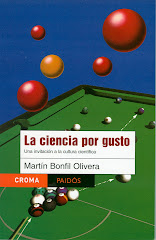by Martín Bonfil Olivera
Published in Milenio Diario, January 28, 2009
 At the beginning of the twentieth century, Russian Aleksandr Oparin and British J.B.S. Haldane proposed (independently) that the distinction between live and inert matter was only an issue of grade, not essence. This means that living beings could have been originated —without divine intervention— from inanimate matter (an idea already suggested by Darwin). From then, a dream of all chemists has been to create artificial life: to manufacture a living cell from only its essential components.
At the beginning of the twentieth century, Russian Aleksandr Oparin and British J.B.S. Haldane proposed (independently) that the distinction between live and inert matter was only an issue of grade, not essence. This means that living beings could have been originated —without divine intervention— from inanimate matter (an idea already suggested by Darwin). From then, a dream of all chemists has been to create artificial life: to manufacture a living cell from only its essential components.
The possibility is still far away, but a recent paper by molecular biologists Tracey Lincoln and Gerald Joyce, from Scripps Institute in
Lincoln and Joyce started from one of the most currently accepted theories about the origin of life. The genome of all living organisms is made of deoxyribonucleic acid (DNA), a molecule shaped like a double helix that can copy itself, if it has help from the proper enzymes —molecular machines.
But there is abundant evidence that maybe the first molecule capable of auto-reproduction was not DNA, but its cousin, ribonucleic acid (RNA), a molecule that, as discovered in the 80s, can also act as an enzyme (catalyzing chemical reactions).
It is known that there are RNAs capable of cutting and pasting other RNA molecules. Lincoln and Joyce manufactured a pair of synthetic RNA that copy each other. Each molecule consists of two halves: the first RNA the two halves that form the second, and then, this one bonds the halves of another copy of the first one, just like the famous drawing by M.C. Escher of two hands drawing each other. While there is raw material (the four necessary pieces), the process can continue indefinitely, multiplying the RNA couples.
But not only that: Lincoln and Joyce also manufactured some variants of their RNAs and placed them in a "competition". The different available pieces formed new combinations and, after some time, the ones that reproduced faster were predominant in the solution. Evolution in a test tube!
Artificial life is still a dream, but the experiment proves that it is possible, at least in principles. Lets see what the future holds in store.
(translated by Adrián Robles Benavides)
To receive Science for pleasure weekly
in your email, subscribe here!




No comments:
Post a Comment